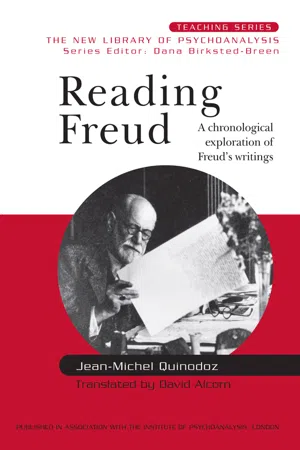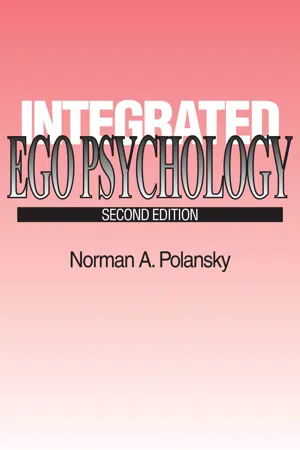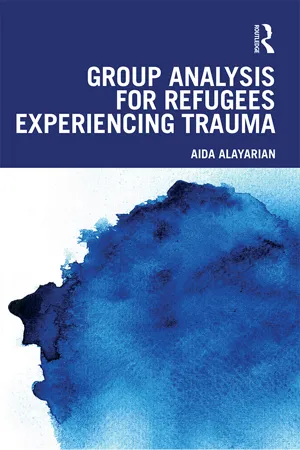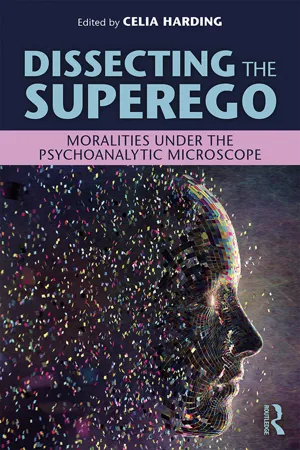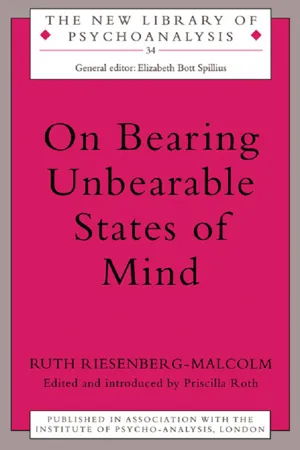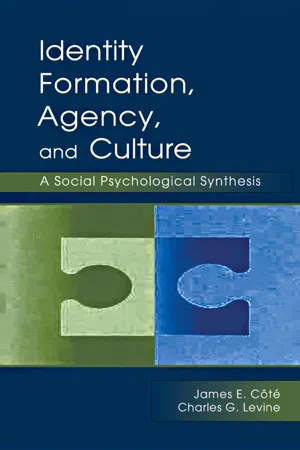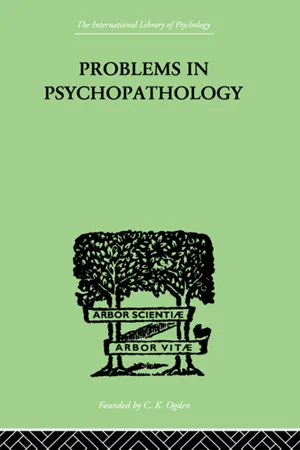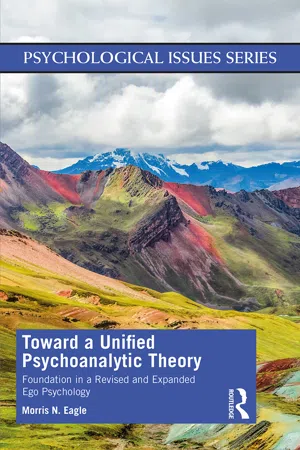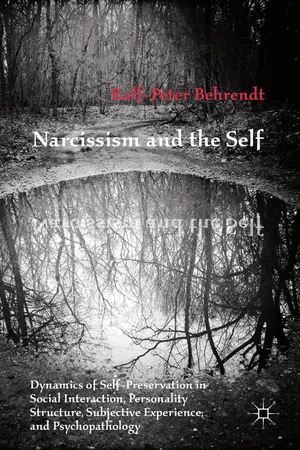Psychology
Id Ego Superego
The id, ego, and superego are three components of Sigmund Freud's structural model of the psyche. The id represents primal instincts and desires, the ego mediates between the id and the external world, and the superego embodies societal and moral standards. These three elements interact to shape an individual's thoughts, behaviors, and personality.
Written by Perlego with AI-assistance
Related key terms
12 Key excerpts on "Id Ego Superego"
- eBook - ePub
Reading Freud
A Chronological Exploration of Freud's Writings
- Jean-Michel Quinodoz(Author)
- 2013(Publication Date)
- Routledge(Publisher)
The Ego and the Id (1923b)
DOI: 10.4324/9781315783109-24A new division of the mind: ego, id and superegoThe Ego and the Id is a particularly important book, because in it Freud presents a synthesis of the hypotheses he put forward since the “1920 turning-point”. He begins by showing how his original model of the mind with its division into Unconscious, Preconscious and Conscious systems – his “first structural theory” with its topographical division of the mind – was no longer adequate for describing how the mental apparatus functions; the model would have to be developed further. Taking as his basis the fact that, in the course of psychoanalytic treatment, the “ego” shows resistance towards becoming aware of the real issues, Freud introduces a new division of the mental apparatus. Henceforth there are three agencies – the ego, the id and the superego; this model is known as his “second structural theory”. The two models are not mutually exclusive; indeed, quite the contrary – they complement each other in the sense that they describe the same mental phenomena from two different perspectives, much as we could describe a house in terms of its general shape, its dimensions and its price.In Freud’s definition of the terms, ego, id and superego all have the quality of being both conscious and unconscious. The idea of the ego was present from the very beginning of Freud’s work, though he uses it at first to designate the conscious personality or individual self. From 1923 on, the ego is conceived of as a regulatory agency with respect to mental phenomena, because it is always attempting to reconcile the demands of the id – the “reservoir of libido” – and those of the superego (which Freud had previously called the censor or conscience in the moral sense of the word). The unconscious conflicts and tensions thus created between ego, id and superego with their contradictory demands have a lasting influence on personality development – the outcome of the struggle between the different forces and of the dynamic equilibrium which is set up between them. If the aim of any analysis is to make the unconscious conscious (in terms of the first topographical model), this same aim can be expressed in terms of the second structural theory as “Wo Es war, soll Ich werden” (“Where id was, there ego shall be - eBook - ePub
NeuroAnalysis
Bridging the Gap between Neuroscience, Psychoanalysis and Psychiatry
- Avi Peled(Author)
- 2008(Publication Date)
- Routledge(Publisher)
The conception of the id and ego forms the “structural” model of the psyche; they are hypothetical constructs. We can refer to them when observing behavior, as they serve to explain actions and attitudes. This is also relevant to all other psychological formulations.The ego develops gradually as the infant grows to adulthood. The development of the ego reflects the maturation of the mental psyche apparatus as it manifests in a more organized fashion. Through parental training and early childhood education, as the ego develops it incorporates cultural and social norms as parent images within the ego, which Freud called the superego.The superego has a censoring and criticizing power. It incorporates the norms and standards of society, and also includes parental attitudes as well as the ideals and self-expectations of the person. Because it was created in early childhood and infancy the superego is mostly unconscious and thus unavailable for reality testing. Irrational self-blame and excessive harshness with one’s own feelings and behavior is partly explained by the powers of the superego.Freud viewed the ego as the great mediator. In an executive manner the ego acts to reconcile the id, the superego, and the outside world of events. The ego must allow the id to discharge energy but not to the extent that it damages the organization of the ego. In particular, the ego needs to mediate the conflicting forces of the id and the superego. A balance between appropriate interaction with the dynamic outer world should be maintained; thus the individual’s attitudes and reactions will remain adaptable and reconciled with the external environment.Neurologically the id is first expressed in infancy. The id is initially disorganized, as the extra-pyramidal motor system is undeveloped. Sensory experience has not been integrated and the infant, who is initially blind; and may initially not associate various experiences, when he begins to see objects. For example, the infant may see his own hand touching an object but may not yet experience the hand as being his own hand. Thus psychologically the infant experiences the world as chaotic, uncontrolled, and disorganized. As connections are made between and within neuronal systems, both experiences become organized and associated and the motor response gradually coordinates to become goal directed and response related. - eBook - ePub
- David P. Farrington, David P. Farrington(Authors)
- 2017(Publication Date)
- Routledge(Publisher)
The image we have is of two people negotiating, one knave and one sanctimonious hypocrite. It comes as a jolt to recognize neither Mr. Id nor his corruptible confederate are real persons, nor identifiable bits of the personality. Each is, in fact, an abstraction, a label given to a set of mental processes and operations. In the case of the ego, we refer to the functions subsumed under that concept (Stamm 1959; Wasserman 1974). Within the corpus of Freudian theory itself, ego psychology is to be distinguished from id psychology, the first area emphasized in developing the theory. As we shall see, the id has to do with drives, instincts, emotions, the energies that impel the personality. Ego psychology has to do with adaptation ; the usual description of the ego is that it mediates among the id, the superego, and the environment—external reality. But if the id refers to a multitude of sins, what is the role of the ego? The following specific adaptive functions, commonly taught as ego psychology, seem to me to be of greatest importance for clinicians. Defense mechanisms and the formation of symptoms: Even if they come from undergraduate anti-Freudian departments, nearly all students have some acquaintanceship with defense mechanisms, for these mechanisms have passed from their original auspices into general knowledge. Terms such as rationalization, reaction-formation, and projection are listed and defined in most basic textbooks. A knowledge of the logic of the defenses is useful to anyone undertaking to help others through interviews, for the defenses are among the mental functions most immediately visible when one first meets a client. We shall begin our examination of ego psychology by discussing the nature of defense and its role in symptom formation. Object relations: The theory of object relations contains many of the most exciting advances associated with ego psychology - eBook - ePub
- Aida Alayarian(Author)
- 2023(Publication Date)
- Routledge(Publisher)
Gives rise to socially derived feelings of guilt, as we recognise that we can never displace our powerful parent. In a male, it puts the child at risk which he perceives when he pursues the sexual attraction for his mother, he fears to be harmed by his father. This is the castration anxiety. As male attraction for mother and hatred for the father is not acceptable it should be repressed, the child may resolves the conflict of the Oedipus complex by coming to identify with the parent of the same sex. This is in the latency period, in which sexual motivations become much less pronounced and will lasts until puberty when mature genital development begins and the pleasure drive focuses around the genital area.In the developmental stages a movement through a series of conflicts is necessary and the positive efficacious resolutions of these processes are essential for psychological health. Many psychological weaknesses and complaints, particularly hysteria can easily be traced back to disturbances in these stages and unresolved conflicts which interrupt the usual pattern of development.The id, ego, and super-ego
It can be said that Freud’s (1915b) account of the unconscious and the structure of mind is similar to Plato’s account of the nature of psychological well-being, which Freud formulated with the establishment of a harmonious relationship between the three structural elements which distinguish and constitute the mind to id, ego and superego.- The id is the unconscious mind, the part of the mind in which the instinctual sexual drives for pleasure are situated.
- The ego is the conscious self of dynamic tensions and interactions between the id and the superego which has the task of integrating conflicting demands with the requirements of external reality. All objects of consciousness reside in the ego.
- The superego
- eBook - ePub
Dissecting the Superego
Moralities Under the Psychoanalytic Microscope
- Celia Harding, Celia Harding(Authors)
- 2018(Publication Date)
- Routledge(Publisher)
Way-stations included ‘conscience’ (Freud, 1913: p. 67); a specialist ego compartment standing over the ego as its judge (Freud, 1917: p. 247); and an ‘ego ideal’ against which the ego measures its worth (Freud, 1914: p. 93ff, see Horne, Chapter 3). 1 Freud primarily focused on the development of individuals as instinctual beings obliged to import from their social and cultural worlds the ways and means of civilising their anti-social impulses to equip them for social life (Freud, 1930). Children begin to develop a superego, building on the neurological, emotional and physical foundations established in the earliest mother–baby relationship (see Hinshelwood, Chapter 1 ; Narvaez, Chapter 4), as (m)others induct them into the social rules of getting on with others. The superego thereby becomes the guardian of personal social probity and belonging, pressurising the ego to moderate and modify instinctual impulses and holding the ego to its ideals of the person they aspire to be. At this point, the superego appeared as the ‘representative-of-society-in-mind’ as a necessary ‘add-on’ in order that people may become socially acceptable. Before long, psychoanalytic focus extended – beyond the child’s instinctual development and interest in objects as satisfiers (or frustraters) of their instinctual desires (Freud, 1905) – to the child’s relational environment. For example, Fairbairn (1952) proposed that ‘libido is not primarily pleasure-seeking, but object seeking’ (p. 137). Infants were now understood as orientating themselves to (m)others as incipient social beings, seeking intrinsically valuable connexions with her. Individual development came to be seen as evolving in the context and matrix of relationships: the development of the infant has come to be seen increasingly as something happening within, and shaped by a human context, not, as Freud might have at times liked to think, a spontaneous unfolding of preprogrammed instincts. (Wright, 1991: p - eBook - ePub
- Ruth Riesenberg-Malcolm, Priscilla Roth, Priscilla Roth(Authors)
- 2003(Publication Date)
- Routledge(Publisher)
3 The Constitution and Operation of the Superego
DOI: 10.4324/9780203360897-3I will try to explain the history of the development of the superego, which I take to be the history of the evolution of internal objects from birth through infancy and childhood. I will first emphasise those aspects of the objects that do not ever become totally altered by further development, but remain forever as part of the personality. I will present two examples. In the first one I shall present a fragment of the beginning of an analysis to show how in that patient her objects had not changed and then I will describe three sessions of another patient to show how the objects changed in the sessions.Freud considered superego formation to be mainly the result of the resolution and demolition of the Oedipus Complex. He thought the ego was formed earlier than the superego. Freud was aware of the role which early identifications as well as Oedipal phenomena play in the formation of the superego. In The Ego and the Id he says:the effect of the identifications made in earliest childhood will be general and lasting. This leads us back to the origin of the ego ideal; for behind there lies hidden an individual’s first and most important identification, his identification with the father in his own prehistory [in a footnote he adds that perhaps it would be safer to add with the ‘parents’].(31)He describes this early identification as ‘apparently…not a consequence of an object cathexes…and it takes place earlier than object cathexes’. He adds ‘But the object-choices belonging to the first sexual period and relating to the father and mother seem normally to find their outcome in an identification of this kind, and would reinforce the primary one’ (1923– 7:31). Though Freud clearly expresses the importance of these early identifications, he does not explicitly link them to the character of the superego. - eBook - ePub
Individuation and Narcissism
The psychology of self in Jung and Kohut
- Mario Jacoby(Author)
- 2016(Publication Date)
- Routledge(Publisher)
In the psychoanalytic view the establishment of even a rudimentary identity, a feeling of self in contradistinction to everything that is ‘not self’, is not identical with ego development, though it is closely associated with it. It is difficult to provide a definition of what is understood by the term ego in Freud’s structural theory and in subsequent developments. In the broadest sense it may be understood as the representation of the reality principle in the psyche, requiring a wide range of functions. Heinz Hartmann emphasizes this aspect of the ego’s functions: ‘it is by no means only the “awareness” or the “feeling” of one’s self. In analysis, the ego is a concept of quite different order. It is a substructure of personality and is defined by its functions’ (Hartmann, 1964: 114).The functions of the ego that were most thoroughly investigated by psychoanalysis at first are those of its (generally unconscious) defences against those instinctual forces that are seen as being harmful or dangerous from the standpoint of reality (Anna Freud, 1973). Hartmann has pointed out, however, that no analyst has ever attempted to compile a complete list of ego functions, since such a list would be very long indeed. A crude division into ‘organizing’ and ‘inhibiting’ functions might be useful. Among the organizing functions would be coordinating or integrating tendencies in thought and action, along with the differentiating capacity of consciousness. Freud regarded goal-oriented action as an ego function, in contrast to mere motor discharge. As to thinking, Freud regarded it as a testing action carried out with small quantities of psychic energy. The ego tries to include ‘reality-testing’ in its operations. But both thinking and acting are also seen as having an inhibiting element designed to delay discharge; this promotes a more precise and secure form of adjustment by ‘introducing a factor of growing independence from the immediate impact of present stimuli’ (Hartmann, 1964: 115). Control is an important ego function. Hartmann also maintains that ‘another set of functions which we attribute to the ego is what we call a person’s character’ (ibid.). - eBook - ePub
Identity, Formation, Agency, and Culture
A Social Psychological Synthesis
- James E. Cote, Charles G. Levine(Authors)
- 2014(Publication Date)
- Psychology Press(Publisher)
This complexity of self helps us understand how the person moves through “space,” and the superego/ego ideal helps us understand how the person is self-governing within cultural parameters. At the same time, the ego is the source of agency taking the Self and superego/ego ideal through time, while utilizing id drives as a source of energy in mastering cultural obstacles and challenges. Ego identity, then, can be understood as the ego’s sense of agency in moving through space and time; the stronger this sense, the more the ego feels identical to itself from one situation and point in time to the next. Erikson's Theory Compared with Symbolic Interactionism Although rarely acknowledged in the literature, there are a number of unrecognized sociological themes in Erikson’s work that can help us understand better the multidimensionality of identity formation and the links among identity, agency, and culture. Thus, we can build on Erikson’s theory of personality structure and formation, with its focus on ego identity, by linking it with symbolic interactionist concerns of personal and social identity formation. For example, Erikson seems to have shared a number of phenomenological and methodological assumptions with symbolic interactionists with regard to the necessity of understanding the subjective experience of the actor - eBook - ePub
- T.W. Mitchell(Author)
- 2013(Publication Date)
- Routledge(Publisher)
The Ego-ideal is largely a reaction-formation against the libidinal impulses of the Id, and it assists the Ego in its task of trying to overcome the Id, which is entirely non-moral, and consequently a source of danger to the Ego. But just because it is a reaction-formation there is a danger that it may become over-moral and cruel in its severity towards the Ego. We thus get a picture of the Ego assailed on three sides, in bondage to three different masters each of whom it must satisfy if it is to be free from anxiety. Danger to the Ego may come from the outside world, from the libido of the Id, or from the severity of the Ego-ideal.It is not always easy to translate the accepted doctrines of psycho-analysis into the new terminology which has accompanied Freud's division of the mind into the Id, the Ego, and the Ego-ideal. And this difficulty is accentuated by the fact that, coincidently with his adoption of this tri-partite division, he has had occasion to modify some parts of his former teaching. For example, when he first propounded his conception of narcissism he held that the Ego was the original reservoir of the Libido, and that from the Ego the Libido overflowed towards objects very much as an amæboid organism may push out protoplasmic feelers towards the outer world. We have now to recognize, however, that when the distinction between Ego and Id has arisen, the Id is the great reservoir of Libido. At first all Libido is accumulated in the Id, but is directed towards the Ego (primary narcissism), whilst the Ego is still inchoate and feeble. Erotic impulses arise in the Id as urgent needs, and the investment of objects with Libido emanates from the Id. The Ego comes to know of these libidinal impulses, directed towards objects, and either accepts them or tries to defend itself against them by repression. Or, if it cannot accept them, the Ego may more effectually master the Id by identifying itself with the object that has to be renounced. In so doing it tries to impose itself upon the Id as a substitute for the lost love-object : it is as if it said : “Look, you can love me, too, I am so like the object you loved !” The narcissism thus produced by identification is therefore a secondary narcissism, - eBook - ePub
Toward a Unified Psychoanalytic Theory
Foundation in a Revised and Expanded Ego Psychology
- Morris N Eagle(Author)
- 2021(Publication Date)
- Routledge(Publisher)
An outline of psychoanalysis, the demise of the concept of ego instincts is essentially complete, along with the possibility of recognizing distinctive ego motives. The ego is now conceptualized as a structure with various functions, including voluntary movement, perception, memory, response to danger, learning, and adaptation. Freud (1940 [1938]) writes that the functions and tasks of the ego are “gaining control over the demands of the instincts” (p. 146) and “discover[ing] the most favorable and least perilous method of obtaining satisfaction, taking the external world into account” (p. 148).Thus, according to this id-ego model, the instinctual drives (id) provide the energy for mental functioning – only a wish can set the mind in motion (Freud, 1950 [1895]) – and are the source of our motives and desires, whereas the ego controls and channels these motives and desires. (Recall Freud’s [1923 (1961)] horse and rider metaphor). In this model, the ego is essentially equated with mental functioning, which serves biologically based drives that generate inner stimuli that activate and make demands on the mind. It is then the primary function of the mind (a central aspect of which is ego structure) to find ways in reality to discharge the tensions associated with drives – in psychological terms, to gratify needs, wishes, and desires. There is no room in this model for distinctive ego motives and desires, that is, motives and desires linked to ego functioning. If one harbors any doubt as to Freud’s views regarding the fundamental source of our aims and motives, to dispel these doubts, one need only turn to his comment late in his writings that “the power of the id expresses the true purpose of the individual’s or organism’s life” (Freud, 1940 [1938], p. 148), with the overriding task of the ego residing in the carrying out the id’s purpose in a reality-oriented way. As G.S. Klein (1976) has observed, when ego functions are referred to by Freud, function is understood “in an entirely non-motivational sense” (p. 153) (emphasis in the original). Although Freud toyed with the idea of motives and aims specifically linked to the ego and ego functions, they were never granted full motivational properties. Rather, behaviors linked to ego functions were accorded the status of “interests” (interesse - eBook - ePub
Narcissism and the Self
Dynamics of Self-Preservation in Social Interaction, Personality Structure, Subjective Experience, and Psychopathology
- R. Behrendt(Author)
- 2015(Publication Date)
- Palgrave Macmillan(Publisher)
315) (and that thus became part of the self), although “the representation of the original persons was repressed” and “only the inhibiting and direction-giving power remained in consciousness” (F EDERN, 1952, p. 316). The superego, “be it demanding, prohibiting, or permitting, … always deals in the first place with the ego” (p. 309). Whenever the superego uses “functions of moral evaluation, demand, and rejection” vis-à-vis the ego (p. 312), “the boundary between ego and superego leads to a division in the ego, so that one becomes aware in oneself of that double structure” (p. 313). The boundary between ego and superego is accentuated when there is “strict supervision on the one side” and “intense fear of this supervision on the other” (F EDERN, 1952, p. 314). The ego is libidinally attached to the superego; and, as “the ego accepts the superego’s orders”, the superego invests (narcissistic) libido in the ego (F EDERN, 1952, p. 309). Acting in accordance with one’s ego ideal is a source of pride or self-esteem, reflecting a strong narcissistic cathexis of the ego (a strong ‘ego feeling’). The ego’s narcissistic strivings can be satisfied – and ‘ego libido’ (narcissistic cathexis of the ego) can be increased to the point of “joyful tension” – when “claims on one’s own ego” can be fulfilled, that is, when one’s ego ideal can be approximated (p. 353). The superego is associated with ‘ego feeling’ when one adopts the perspective of the superego; “the ego and the superego actually correspond to two ego feelings, that is, to two unities of ego libido, each homogenous in itself, but not with the other” (pp. 314–15). The torments of self-reproach illustrate that “the ego vacillates between ego and superego in peculiar manner” and that “one cannot simultaneously be ego and superego” (p. 314). One has to lose “the sensation of one’s ego before one gains that of one’s superego, and vice versa” (F EDERN, 1952, p - Eda Goldstein(Author)
- 2010(Publication Date)
- Free Press(Publisher)
People are driven by sexual and aggressive drives and unconscious wishes and fears; people are doomed to suffer or destroy unless impulses are tamed; behavior is strictly determined; childhood events are important People are born with innate adaptive capacity; the person is a biopsychosocial being; early childhood and adult life events all through the life cycle are critical Structural Concepts Id, ego, and superego The ego’s numerous functions are described and emphasized Developmental Concepts Infantile sexuality and psychosexual stages The maturation of conflict-free or autonomous ego functioning Fixation and regression The role of the average expectable environment Identification Psychosocial stages Anxiety, conflict, and defense The importance of stage-specific parenting The process of coping and adaptation Person-environmental mutuality Stress and crisisClassical Freudian Theory Ego Psychology Nature of Problems Individual neurotic symptoms Individual problems in ego functioning stemming from developmental difficulties Neurotic characters Life transitions and stressful events Unconscious oedipal conflict Ego deficits Fixations, regression, and defenses Maladaptive defenses Compromise formations Lack of fit between inner capacities and external resources or conditions Maladaptive coping Nature of Change Insight and conflict resolution Ego mastery
Learn about this page
Index pages curate the most relevant extracts from our library of academic textbooks. They’ve been created using an in-house natural language model (NLM), each adding context and meaning to key research topics.
